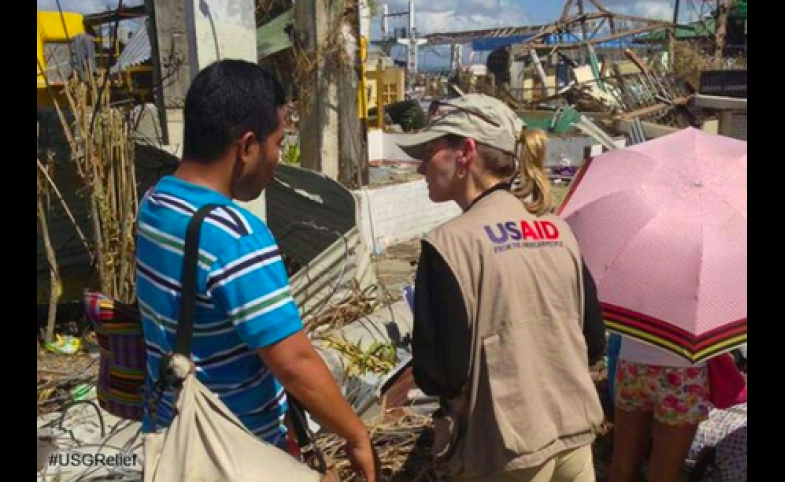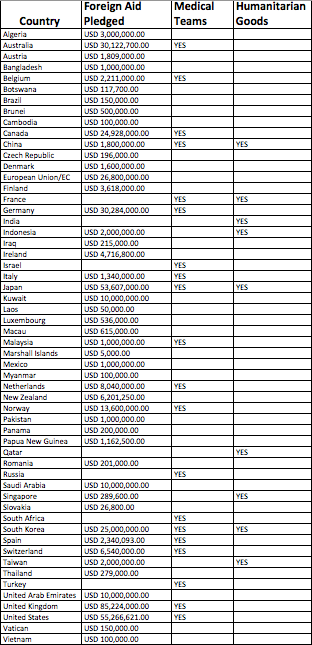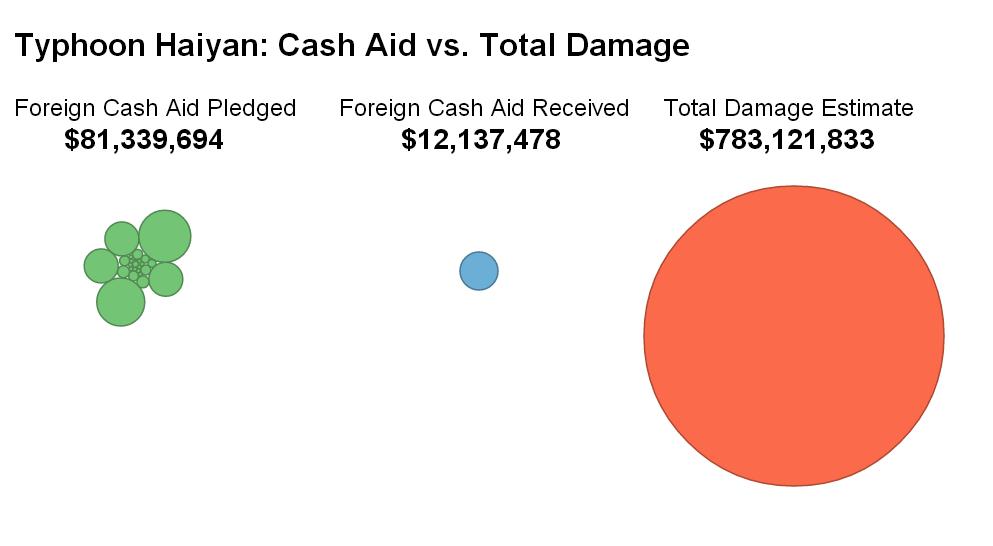It would seem impossible for the Taliban to get good publicity in Western media, but the unthinkable nearly happened on December 16, 2014. How? The Taliban tricked the press by using a powerful communications technique: the...
KEEP READINGThe CPD Blog is intended to stimulate dialog among scholars and practitioners from around the world in the public diplomacy sphere. The opinions represented here are the authors' own and do not necessarily reflect CPD's views. For blogger guidelines, click here.

Public Diplomacy in the aftermath of Typhoon Haiyan
Public diplomacy (PD), if defined as the act of a government engaging directly with a foreign public, then many governments are currently conducting PD towards the Filipino public in the aftermath of Typhoon Haiyan's devastation. Most public diplomacy scholars and practitioners refer to the foreign aid assistance in the wake of a disaster as "aid diplomacy." This aid diplomacy is often spoken about in terms of foreign aid packages, goodwill gestures, and how foreign aid can help to increase a public's positive attitudes towards the aid-providing country. When it comes to foreign aid, these packages are usually seen as drivers of goodwill and the implementation of a nation's soft power, but we must acknowledge that economic incentives are generally considered a coercive tool of hard power. It is important to remember that public diplomacy experts understand that PD is not a strategy of merely goodwill and smiles, but a national interest driven foreign policy strategy. Therefore, we should look at aid diplomacy with a discerning lens, and make assessments based on direct impact.
While it has been demonstrated in the aftermath of the nuclear disaster in Japan, and after the earthquake in Pakistan, that public opinion towards the U.S., for example, after the delivery of foreign aid is correlated with rising positive attitudes toward the United States. However, is it the amount of financial aid that helps to create positive sentiments after these disasters, or is it something else?
Could it be that the on-the-ground presence of people, diplomats, aid and rescue workers, foreign medical teams, or branded-food, shelter, and clothing supplies, make the greatest public diplomacy impact? With 5,670 dead, 1,761 missing, 26,322 injured and 11.2 million people affected, of which 4.1 million are currently displaced, what does the aid diplomacy look like for the Filipino people affected by Typhoon Haiyan?
See Vizynary for more information about this graphic.
Foreign aid packages to the Philippines, according to the latest report issued on December 2 by the Foreign Aid Transparency Hub (FAiTH) notes that while $504 million has been pledged by 49 countries including the Vatican, the European Union, as well as a number of multilateral organizations and international NGOs (excluding the UN), only $12 million has been disbursed.
In a disaster, where immediate relief is needed, the large majority of foreign aid is tangled in the bureaucratic distribution process and isn't helping the people. So, what is impacting the public? It's not the inaccessible $492 million pledged to the Philippines. So is there significant aid diplomacy currently being conducted?
Well, let's take a look at the on-the-ground relief efforts being conducted in the immediate aftermath of the super typhoon. According to the Philippines government report "National Diaster Risk Reduction and Management Council (NDRRMC)," a total of 25 countries are currently in the Philippines providing medical and humanitarian relief.
56 Countries Providing Relief to the Philippines

Of these 25 countries, only China, Japan, and South Korea are providing financial, medical, and humanitarian aid. Only Western countries, with the exception of Malaysia, contributed both foreign aid and on-the-ground medical teams including Australia, Belgium, Canada, Germany, Italy, the Netherlands, Norway, Spain, Switzerland, the United Kingdom, and the United States. Indonesia, Singapore, and Taiwan are the only countries providing both foreign aid and humanitarian goods. While an interesting grouping of countries, Israel, Russia, South Africa, and Turkey, only committed medical assistance. India and Qatar provided only humanitarian goods, while France was the only country to not provide financial aid, but sent medical teams and humanitarian goods.*
So to answer the questions raised above, yes, aid diplomacy is being conducted in the Philippines, but it is done so by the few thousand people on the ground who are providing medical assistance, clean water, food, shelter, and other basic necessities. These 25 countries that chose to send goods and people are the aid diplomacy heroes to the Filipino people, regardless of the amount of money they pledged to the government of the Philippines. While the millions pledged will be a necessity down the line for reconstruction, it is not what drives the immediate public impact.
Based on the understanding that public diplomacy must directly impact the public, and circumvent the government-to-government relationship, public diplomacy scholars and practitioners should not be considering foreign aid a direct PD tool. However, on-the-ground assistance must take center-stage as the defining component of aid diplomacy.
*Please note, this piece is only tackling the public diplomacy of traditional government agencies which are not the only actors participating in the immediate medical and humanitarian relief. There are 18 UN agencies and 138 international NGOs doing so as well, and they are working alongside a total of 94 foreign medical teams.
Below is a list of articles which feature on-the-ground rescue stories in which foreign assistance teams provided immediate relief to Filipinos in need.
CANADA
Canada to Match Donations Made By its Citizens to Typhoon Victims
The Philippine Star
November 12, 2013
ISRAEL
First Baby Born In IDF Field Hospital in Philippines Named ‘Israel’
The Times of Israel
November 15, 2013
JAPAN
Japan Sending Troops to Aid Philippines
The Wall Street Journal
November 14, 2013
MALAYSIA
Malaysia Offers Aid to Philippines in Wake of Haiyan
The Star Online
November 12, 2013
MULTIPLE COUNTRIES
More Foreign Aid Pours in for Typhoon Victims
The Philippine Star
November 11, 2013
RUSSIA
Russia Sends Medical Supplies to Typhoon-hit Phl
The Philippine Star
November 12, 2013
TURKEY
Turkey Joins Relief Efforts in Philippines
Hurriyet Daily News
November 11, 2013
UNITED KINGDOM
Typhoon Haiyan: UK planes take aid to Philippines
BBC News
November 18, 2013
Visit CPD's Online Library
Explore CPD's vast online database featuring the latest books, articles, speeches and information on international organizations dedicated to public diplomacy.
POPULAR ARTICLES
-
November 5
-
November 13
-
November 25
-
December 17
-
December 15
Join the Conversation
Interested in contributing to the CPD Blog? We welcome your posts. Read our guidelines and find out how you can submit blogs and photo essays >.














